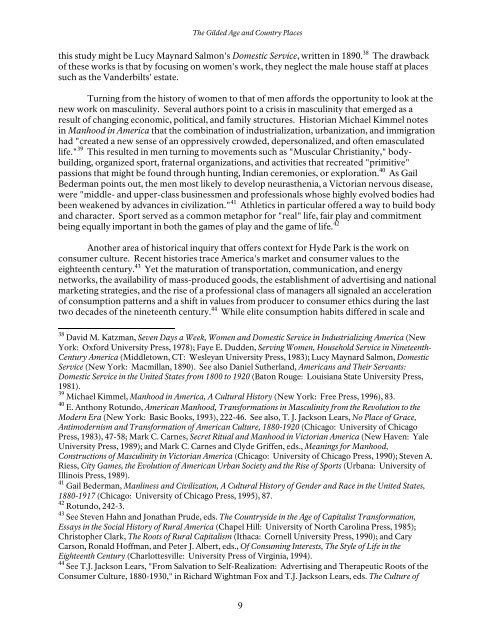National Park Service U.S. Department of the Interior
National Park Service U.S. Department of the Interior
National Park Service U.S. Department of the Interior
Create successful ePaper yourself
Turn your PDF publications into a flip-book with our unique Google optimized e-Paper software.
The Gilded Age and Country Places<br />
this study might be Lucy Maynard Salmon's Domestic <strong>Service</strong>, written in 1890. 38 The drawback<br />
<strong>of</strong> <strong>the</strong>se works is that by focusing on women's work, <strong>the</strong>y neglect <strong>the</strong> male house staff at places<br />
such as <strong>the</strong> Vanderbilts' estate.<br />
Turning from <strong>the</strong> history <strong>of</strong> women to that <strong>of</strong> men affords <strong>the</strong> opportunity to look at <strong>the</strong><br />
new work on masculinity. Several authors point to a crisis in masculinity that emerged as a<br />
result <strong>of</strong> changing economic, political, and family structures. Historian Michael Kimmel notes<br />
in Manhood in America that <strong>the</strong> combination <strong>of</strong> industrialization, urbanization, and immigration<br />
had "created a new sense <strong>of</strong> an oppressively crowded, depersonalized, and <strong>of</strong>ten emasculated<br />
life." 39 This resulted in men turning to movements such as "Muscular Christianity," bodybuilding,<br />
organized sport, fraternal organizations, and activities that recreated "primitive"<br />
passions that might be found through hunting, Indian ceremonies, or exploration. 40 As Gail<br />
Bederman points out, <strong>the</strong> men most likely to develop neuras<strong>the</strong>nia, a Victorian nervous disease,<br />
were "middle- and upper-class businessmen and pr<strong>of</strong>essionals whose highly evolved bodies had<br />
been weakened by advances in civilization." 41 Athletics in particular <strong>of</strong>fered a way to build body<br />
and character. Sport served as a common metaphor for "real" life, fair play and commitment<br />
being equally important in both <strong>the</strong> games <strong>of</strong> play and <strong>the</strong> game <strong>of</strong> life. 42<br />
Ano<strong>the</strong>r area <strong>of</strong> historical inquiry that <strong>of</strong>fers context for Hyde <strong>Park</strong> is <strong>the</strong> work on<br />
consumer culture. Recent histories trace America's market and consumer values to <strong>the</strong><br />
eighteenth century. 43 Yet <strong>the</strong> maturation <strong>of</strong> transportation, communication, and energy<br />
networks, <strong>the</strong> availability <strong>of</strong> mass-produced goods, <strong>the</strong> establishment <strong>of</strong> advertising and national<br />
marketing strategies, and <strong>the</strong> rise <strong>of</strong> a pr<strong>of</strong>essional class <strong>of</strong> managers all signaled an acceleration<br />
<strong>of</strong> consumption patterns and a shift in values from producer to consumer ethics during <strong>the</strong> last<br />
two decades <strong>of</strong> <strong>the</strong> nineteenth century. 44 While elite consumption habits differed in scale and<br />
38<br />
David M. Katzman, Seven Days a Week, Women and Domestic <strong>Service</strong> in Industrializing America (New<br />
York: Oxford University Press, 1978); Faye E. Dudden, Serving Women, Household <strong>Service</strong> in Nineteenth-<br />
Century America (Middletown, CT: Wesleyan University Press, 1983); Lucy Maynard Salmon, Domestic<br />
<strong>Service</strong> (New York: Macmillan, 1890). See also Daniel Su<strong>the</strong>rland, Americans and Their Servants:<br />
Domestic <strong>Service</strong> in <strong>the</strong> United States from 1800 to 1920 (Baton Rouge: Louisiana State University Press,<br />
1981).<br />
39<br />
Michael Kimmel, Manhood in America, A Cultural History (New York: Free Press, 1996), 83.<br />
40<br />
E. Anthony Rotundo, American Manhood, Transformations in Masculinity from <strong>the</strong> Revolution to <strong>the</strong><br />
Modern Era (New York: Basic Books, 1993), 222-46. See also, T. J. Jackson Lears, No Place <strong>of</strong> Grace,<br />
Antimodernism and Transformation <strong>of</strong> American Culture, 1880-1920 (Chicago: University <strong>of</strong> Chicago<br />
Press, 1983), 47-58; Mark C. Carnes, Secret Ritual and Manhood in Victorian America (New Haven: Yale<br />
University Press, 1989); and Mark C. Carnes and Clyde Griffen, eds., Meanings for Manhood,<br />
Constructions <strong>of</strong> Masculinity in Victorian America (Chicago: University <strong>of</strong> Chicago Press, 1990); Steven A.<br />
Riess, City Games, <strong>the</strong> Evolution <strong>of</strong> American Urban Society and <strong>the</strong> Rise <strong>of</strong> Sports (Urbana: University <strong>of</strong><br />
Illinois Press, 1989).<br />
41<br />
Gail Bederman, Manliness and Civilization, A Cultural History <strong>of</strong> Gender and Race in <strong>the</strong> United States,<br />
1880-1917 (Chicago: University <strong>of</strong> Chicago Press, 1995), 87.<br />
42<br />
Rotundo, 242-3.<br />
43<br />
See Steven Hahn and Jonathan Prude, eds. The Countryside in <strong>the</strong> Age <strong>of</strong> Capitalist Transformation,<br />
Essays in <strong>the</strong> Social History <strong>of</strong> Rural America (Chapel Hill: University <strong>of</strong> North Carolina Press, 1985);<br />
Christopher Clark, The Roots <strong>of</strong> Rural Capitalism (Ithaca: Cornell University Press, 1990); and Cary<br />
Carson, Ronald H<strong>of</strong>fman, and Peter J. Albert, eds., Of Consuming Interests, The Style <strong>of</strong> Life in <strong>the</strong><br />
Eighteenth Century (Charlottesville: University Press <strong>of</strong> Virginia, 1994).<br />
44<br />
See T.J. Jackson Lears, "From Salvation to Self-Realization: Advertising and Therapeutic Roots <strong>of</strong> <strong>the</strong><br />
Consumer Culture, 1880-1930," in Richard Wightman Fox and T.J. Jackson Lears, eds. The Culture <strong>of</strong><br />
9

















